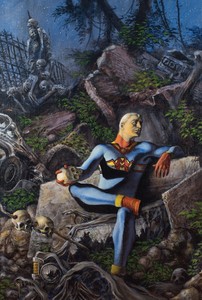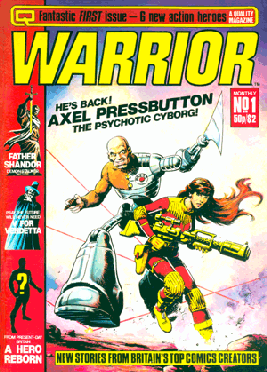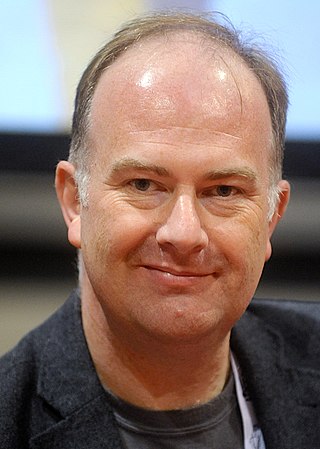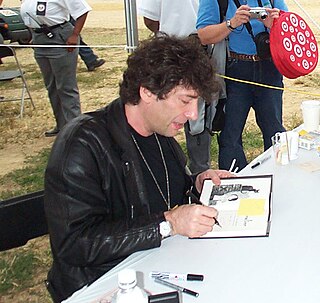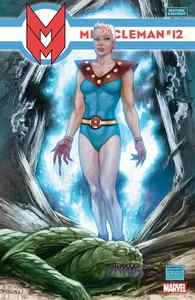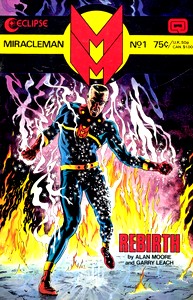Comic book stories
Artist Peter Penman buys a pen from a mysterious shop in a Dorset village. He later discovers that the pen belonged to Merlin and that any drawings made with the pen come to life. He attempts to use monsters created with the pen to blackmail the government for one million pounds. Word reaches the offices of the Daily Bugle, and Micky Moran turns into Miracleman to investigate. Finding himself passing through the illusory monsters he instead locates Penman and uses the pen to draw a version of himself, who rounds up the creatures and drops them on an abandoned moon. The real Miracleman delivers Penman to prison, and plans drop the pen on Pluto to keep it out of harm's way. [7]
A hormonal 11-year old Johnny Bates realises the power he has, especially now he is becoming interested in women, and his dark side is awakened when he kills a couple of witnesses who might have given away his survival. Transforming into Kid Miracleman, he sets his sights on a random passer-by, the 19-year old Angela O'Donnell. While a tract read by a cult preaches the encounter as a charming juvenile romance it instead consists of him brutally raping and murdering her. Exhilarated, he ponders what he will do next. [7]
Despite warnings from Miraclewoman, Miracleman looks through a taunting photo-album created to taunt him by Doctor Gargunza. Its contents depict Mike Moran living happily in a normal life with a pregnant Liz and an unpowered Winter, only for a family holiday to America to be spoilt when an armed robbery shows his alter-ego was never far away. As the album ends with Liz and Winter walking out on him, a downhearted Miracleman tells Miraclewoman he misses them. [7]
Miracleman and Mors meet on the ramparts of Olympus and discuss their latest research – Miracleman is close to finding a cure for aging, while Mors is reaching further and wider in his quest to resurrect the dead – working on bats. The pair plan to meet again the same time the following day, with the words "Same Miracle-Time, Same Miracle-Channel". [7]
At a biblical survivalist compound that believes the new world of Miracleman is evil, a young boy called Abstinence Merridew sneaks away and visits the city. There he finds a utopia compared to the privations of home, and falls in love with a girl called Taina. However he ultimately finds it hollow, and returns to the settlement – only to be shot as he approaches. [8]
Miraclewoman invites a girl called Penny to Olympus after she writes a letter wishing she could visit the palace. The pair play games, and Miraclewoman shows Penny her vast number of robot doubles. Penny accidentally releases them all into the world, causing chaos. She and Miraclewoman round them up but Penny is seemingly hit and killed by shrapnel. However, it is revealed the girl was a robot all along. [8]
Unable to adapt to life without work, a Londoner volunteers to work as a cleaner at Olympus, five days a week, 8am to 5pm. He is unfazed by features such as an anti-matter portal containing the sinister Antijanitor an requiring a space suit to clean a giant, naked statue of Miraclewoman, instead being more interested in his tea breaks. Walking home he is finally amazed when he sees a vintage running Ford Prefect, something he declares a miracle. [8]
Three children called Lucy, Pete and Roy see a shooting star and make a wish. The star is Miracleman, who is heading to Cape Canaveral. There he finds former NASA astronaut Cal Shumaker, bitter at the ending of the space programme since the superhumans made it irrelevant. To help him Miracleman prepares a Space Shuttle for launch, though Cal will only let him perform duties that other support staff would have, and swears him to not involve himself in the actual launch. He follows the shuttle into orbit, where Cal insists on pushing on to Mars. However, he loses control of the shuttle and refuses to let Miracleman intervene. As the shuttle burns up it is mistaken for another shooting star by Lucy, Pete and Roy. [9]
Kid Miracleman investigates an explosion at Licten Labs. He finds Professor Hieronimus Winston, a particle physicist who was attempting to accelerate how fast human bodies could heal. However, the accident has instead left him aging a year every minute. Not knowing what to do, Kid Miracleman unsuccessfully attempts to contact Miracleman and is forced to settle for comforting the Professor. Winston dies before Miracleman arrives, leaving Kid Miracleman's faith in his mentor shaken. [9]
A preacher called Tamblyn preaches a radical doctrine in a survivalist town. He and the other residents believe that Miracleman had sold the planet out to his alien allies and planned to enslave humanity, with Kid Miracleman attempting to stop him. Despite the unflinching belief of the small community Tamblyn's tract is rejected from consideration for the Library of Olympus, and three years later he dies. Following a crop failure the townspeople are left with no choice but to return to the rest of society – but still fervently believing in Tamblyn's teaching. [9]

